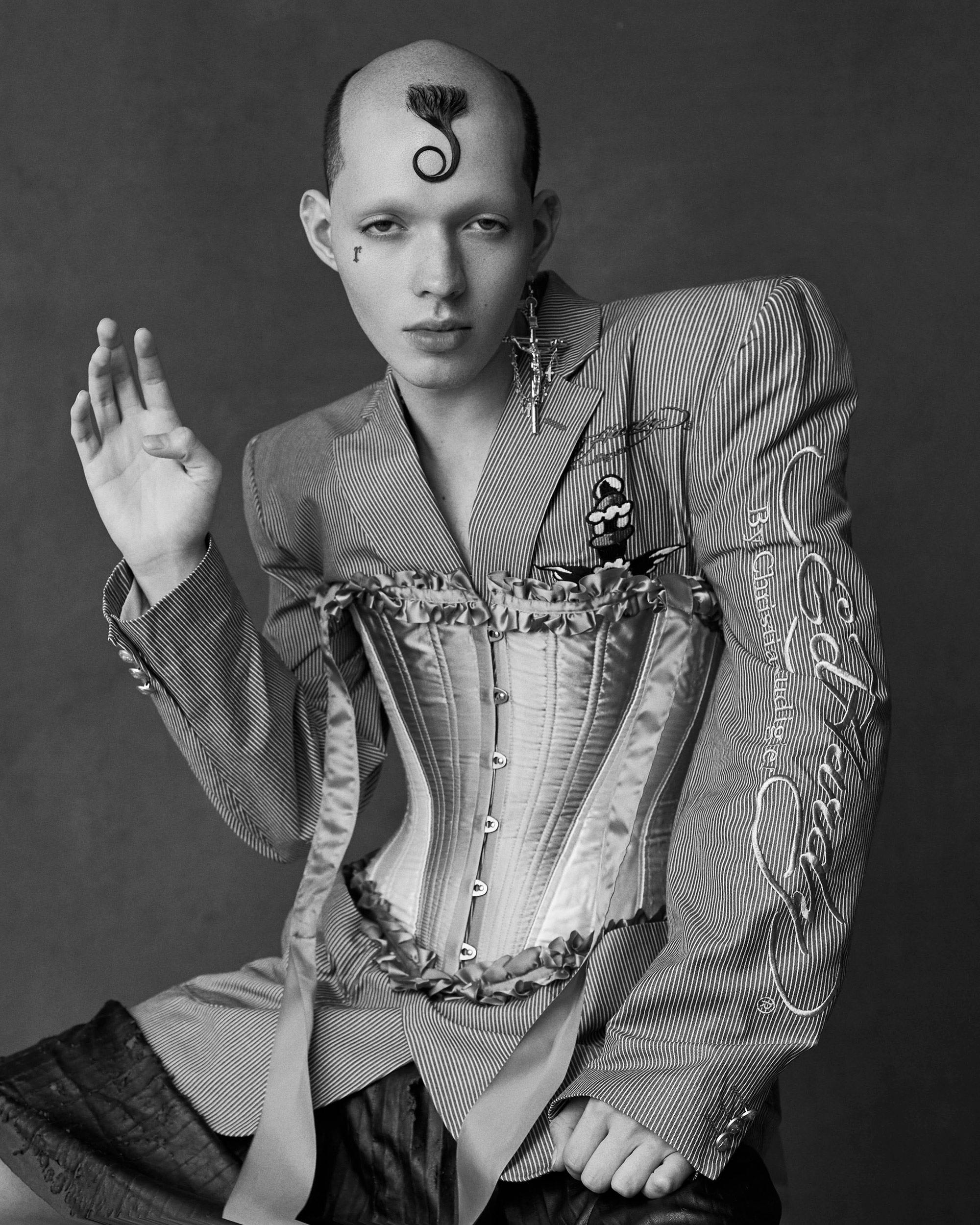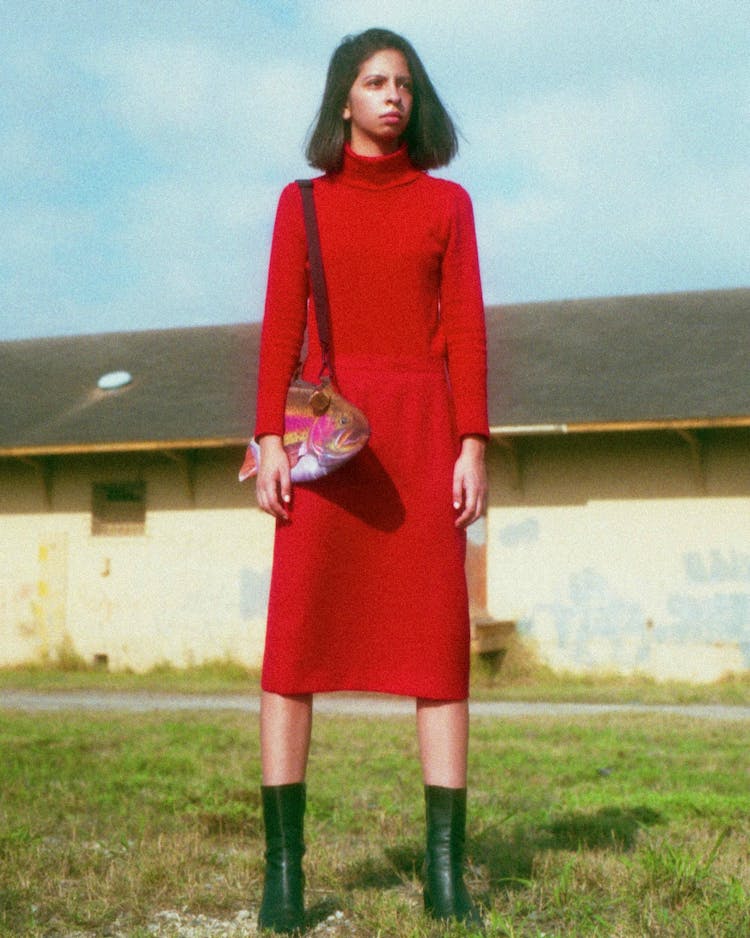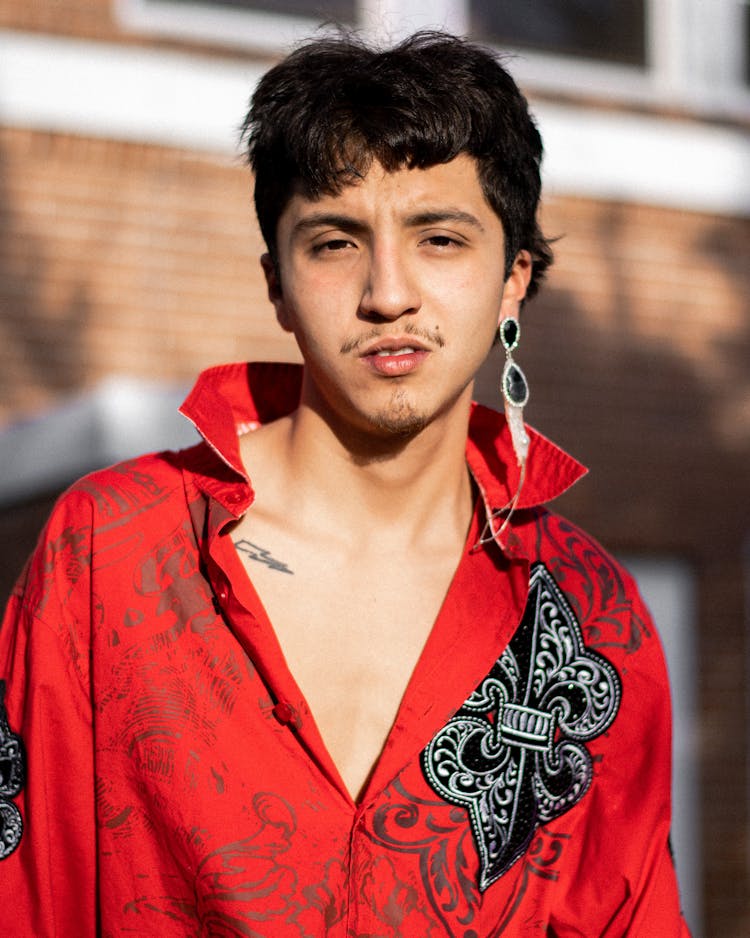Style & Design
Founded by Fish Fiorucci, Lady Gaga’s former muse, the f10 modeling agency is focused on building a fashion community in the Rio Grande Valley.

Vanessa Tellez
When I walk into the casting call in Weslaco, Texas, it feels like I’ve entered an exciting side quest in the video game that is South Texas. The giveaway is the fashion. The room is filled with a masked-up mix of gender-bending Hispanic kids in chunky platforms, dyed mullets, and denim miniskirts. Nolan Navarro, the showrunner of the day, towers over me in ten-inch, patent leather, thigh-high boots. Hushed techno is playing on a Bluetooth speaker while the would-be models get their measurements taken.
Confident and warm, Navarro, who uses the moniker Fish Fiorucci, founded the f10 (internet-speak for f10rucci) modeling agency last September. Based in Brownsville, the agency represents primarily Latino and non-white faces in and around the Rio Grande Valley. Run by queer folks, for queer folks—though being queer is not a requirement—the agency allocates a good chunk of its roster to nonbinary, gender-nonconforming, and transgender people. Its models have walked in fashion shows for brands like Hardeman, Bode, and DYNE, as well as for local RGV designers like Data-Mosh and Max Tijerina. Some of them, like Anissa Garza and Isaac Garcia, have even gone on to sign with international modeling agencies such as Wilhelmina and Major Models.
As the founder and “mother agent” of f10, Fiorucci (who uses they/them pronouns) is tapped into a network of casting calls for both editorial and commercial work. Once they hear of a job, they scan their roster of fifty faces and decide if anyone would be a good fit. Then, they send over “digitals,” the industry term for plain, unedited photos of a model’s front-view and profile, to the casting agent in hopes of getting a placement.
“There’s something that’s happened here in the Valley that has kept us behind for so long as artists,” Fiorucci bemoans in between shooting photos of their new prospects. “But I did my work, I came back, and now I’m just here to share all that information.” Although they’re just 23 years old, their experience is vast. Fiorucci has walked in major shows for designers like Luar and Palomo Spain at New York Fashion Week. In 2019, they were tapped by Lady Gaga to serve as a muse for the music superstar’s beauty brand, Haus Laboratories. Then, the born-and-bred Brownsvillian brought that expertise back home. Fiorucci is the main organizer behind Brownsville Fashion Week, through which they’ve put on avant garde fashion shows along the border wall and in historic Brownsville locations.
Fiorucci is no stranger to the ins and outs—and the shadiness—of the commercial modeling world. They hope to steer young RGV models clear of exploitation and abuse, which can include low- or no-payment gigs, mistreatment on set, or, especially for the genderqueer models, discrimination in the industry. In the process, they hope to highlight the often-overlooked beauty of the Valley. “There’s a huge opportunity at the moment for South Texas to get the light that it finally deserves,” Fiorucci says.

Brenda Bazan
The queer identity of f10 adds a comfort level for transgender and nonbinary models, who are forced to navigate an industry that almost always separates gigs into “male” and “female.” Until the industry begins to see gender as a spectrum, the key is openness and communication, Fiorucci tells me. “I always make sure the models are comfortable with job bookings before I confirm. Forcing nonbinary models to work in cisgender atmospheres can be very harmful and triggering for many people, including me.”
Throughout the next four hours, over twenty ambitious young faces show up to the casting call, eager to be part of the fashion community that Fiorucci is cultivating in the RGV. There’s Liz, the classically Mexican–looking beauty with strong bangs and an even stronger jaw. Kaleb, who has movie-star looks and American Eagle–esque biceps that make you wonder how he hasn’t been scouted already. Marisol poses assuredly in front of the camera wearing a choker and rock-band tank top, armpit hair on full display. Eighteen-year-old Mat (they/them) is delicate and shy, yet feels comfortable exuding femininity in their shots. There’s even Trish, a twelve-year-old transgender girl who walks in with her aunt and little brother. “I want the world to know me,” she says, with an infectious sparkle in her eye. “I wanna be on billboards. I wanna be everywhere.” The shop owner lets Trish play dress-up, and the bubbly middle schooler jumps at the opportunity. (It bewilders me that she isn’t yet famous on TikTok.)
Though f10 is still new, Fiorucci has long served as a mentor for undiscovered talent in the Valley. And whereas most Texas agencies don’t even have divisions for trans or nonbinary models, f10 makes it a point to lead with them. “My faces are special because they’re the brave ones in the Valley,” Fiorucci tells me. “They’re the ones who put themselves out there and wanted a little bit more out of life.”
In Brownsville, according to 2019 census estimates, 94 percent of residents are Hispanic and nearly 30 percent live below the poverty line. The border town is rich with culture, but fraught with residents who struggle to make ends meet. “The hustle to survive is real,” new model Marisol explains. “For me, living in the Valley is a constant struggle for justice and expression.” For a lot of these young people, modeling is an escape. For those who want one, it could even be a ticket out.
It’s embedded in the f10 ethos not just to embrace otherness, but to seek it out. The city of Brownsville has been supportive, giving Fiorucci multiple proclamations and grants to throw fashion shows. Fiorucci is a founding member of Brownsville’s first-ever LGBTQ task force, a city-sponsored program that was created just last year by local drag queen Beatrix. In spite of the city’s support, Fiorucci says there’s still a ways to go before changing residents’ attitudes about equality. “We raised our first equality flag a few months ago at the city’s visiting center, and the place got vandalized and someone stole the flag,” Fiorucci tells me. “People are not allowed to dream down here.”
It’s nearing the end of the day, but before heading back in from a smoke break, Fiorucci gives the team a stern reminder: “Remember to ask people about their pronouns. There are nonbinary people here—just don’t be afraid to ask.”

Katrina Ortega, an f10 model shot in Brownsville in May 2019.
Fish Fiorucci

David Danko, an f10 model shot in Brownsville in November 2020.
Fish Fiorucci
The next day, we meet at Fiorucci’s house in downtown Brownsville for a small kick-back with some of f10’s models. Despite the agency’s queer ethos, not all models identify as queer. There are straight, cisgender faces like John Judas, 20, who works at Walmart and looks like he could be the male lead in the next Pedro Almodóvar film. Alejandro, 23, goes around offering everyone cheese and crackers. “Growing up, I was constantly surrounded by machismo, or toxic masculinity,” Alejandro tells me. “I didn’t feel allowed to express myself fully. But f10 welcomed my authentic self with open arms.”
I start to understand how f10 is not just a modeling agency: it’s a small, invigorated community that is leading the paradigm shift in Brownsville. “I’ve always imagined Brownsville to be the center point between New York and L.A. for fashion,” Fiorucci says. Geographically speaking, that comment makes sense, but it also touches on the untapped potential of a place like the RGV. “If anything, the people coming out of Brownsville are producing amazing results because growing up, nobody expected us to make any noise, which just added fuel to the fire,” Alejandro adds.
Their words ring true to me, a Latino queer person with strong ties to Brownsville. When you’re surrounded by a general intolerance toward queerness for so long—not to mention by the increasing number of Latino Trump supporters in the border region—it almost pushes you to be even weirder, to be even more queer. And with so many people from major cities like New York and L.A. migrating to Texas, Brownsville is in position to become a new creative hot spot.
I envision Fiorucci walking down the street in their stripper heels, shaved head, and face tattoo, and realize that they must garner unwarranted attention sometimes. “I’ve been approached many times downtown, even when I look normal, by people who just wanna f— with me,” they tell me.
My mind kept going back to Trish, the twelve-year-old trans girl who lit up the room when she walked in. Too often, the queer experience is defined by the moments in which your identity gets ripped away from you. “My parents would hide my heels for the longest time,” Fiorucci tells me. “It really took a toll on me.” So many of us have moments like that. But Trish’s contagious zest for life, as well as her family’s unrelenting support, signals a change for queer dreamers in the Valley. “I’m so blessed to be born in a family like this,” Trish explains.
As I get on the highway to go home, I pass the newly built SpaceX South Texas launch site. One day, rockets are meant to be launched from the coast. But Fiorucci and their chosen family of forward-thinking young people are already launching the Valley into the future, turning potential energy into kinetic, and turning looks as an added bonus. “You have to put it in their face,” Fiorucci explains. “Or else they’re not going to pay attention.”
